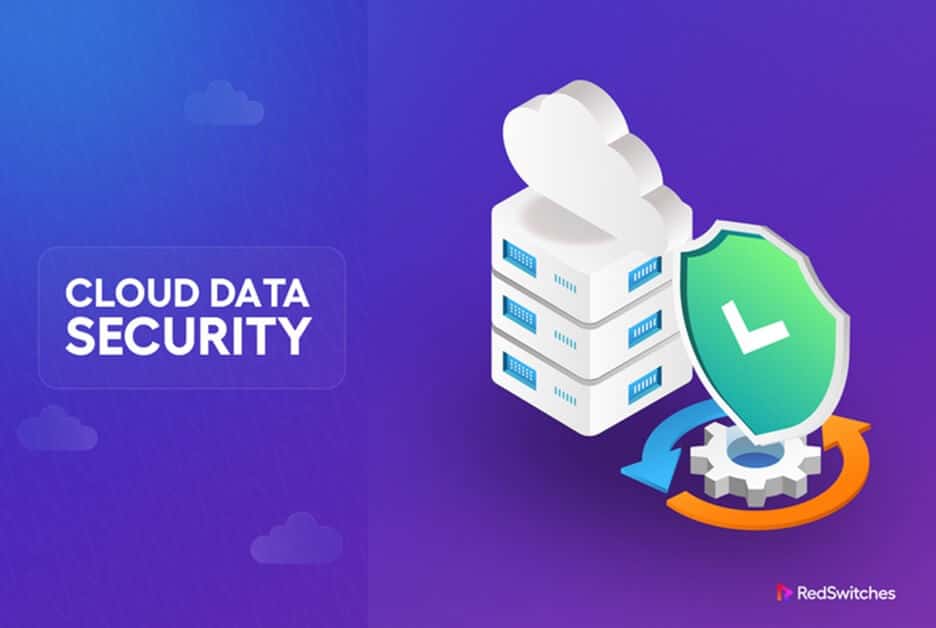Cloud data security is becoming more important as more companies migrate to the cloud. IDG reported in 2018 that 73% of organizations had their infrastructure or applications in the cloud. A further 17% were expected to move in the coming year.
Such an increased population of companies in the cloud leads to massive amounts of data being available online. Data security in cloud computing is at a considerable risk of misuse, theft, or distortion. Properly implementing robust data security strategies can help mitigate such cyber threats.
Businesses cannot fail to adopt cloud computing and digital transformation as they modernize their operational approach. However, they need to guard against both external and internal cyber threats. This is why data security is important in cloud computing.
Therefore, organizations must balance productivity levels and security as they adopt more modern technologies and optimize their operations. Read on to learn what data cloud security is, its types and benefits, as well as its challenges and approaches.
Table of Content
- What is Cloud Data Security? Why Is It So Important?
- What Are the Aspects of Data Security in Cloud Computing?
- Types of Cloud Data Security?
- The Benefits of Cloud Data Security
- Why Do Companies Need Cloud Data Security
- What Are The Challenges of Cloud Data Security?
- How to Approach Data Security?
- Key Takeaways
- FAQs
What is Cloud Data Security? Why Is It So Important?
Cloud data security safeguards digital data from theft, corruption, or unauthorized access throughout its lifecycle. It is a practice that includes all aspects of information security. This consists of the physical security of storage devices and hardware, access policies, and software security.
Data security threats in the world of cloud computing are advancing every day as the digital landscape evolves. Third-party cloud service providers, for instance, may fail to prioritize data asset security and accountability. Businesses then have to protect their workloads and apps.
Implementing robust data security measures ensures an organization’s data assets are secure from cybercriminals. It also helps to prevent insider threats and human error, which are leading causes of data breaches.
What Are the Aspects of Data Security in Cloud Computing?
While the cloud offers an excellent mechanism for storing, managing, and sharing data, it also has some risks. Organizations must know these risks and take the right actions toward increasing cloud security on their customer data.
The essential aspects to ensure when enforcing data security in cloud computing include:
- Encrypting data: This helps to protect private data and security in the cloud from unauthorized individuals.
- Backing up information: This ensures that business operations can continue even if the data stored in the cloud is stolen, lost, or compromised.
- Finding out the security features offered by a cloud provider: This enables organizations to know the safety status of their data in the cloud.
Types of Cloud Data Security?
Data cloud security requires multiple action plans to ensure protection from exposed vulnerabilities and emerging threats. Below are the most common forms of cloud data security.
Physical Security
Physical security prevents hardware theft, such as servers and data centers, among other physical assets.
Physical security mechanisms in the cloud include physical barriers such as motion detectors, surveillance cameras, and access control systems. Such barriers help to protect data by preventing illegal access to server rooms or data centers.
In essence, physical security institutes precautions such as those stated above to prevent sabotage, vandalism, theft, and other physical attacks. The precautions could also help with the identification and handling of security lapses. On most occasions, it is the responsibility of cloud service providers.
Network Security
Network security prevents undesired access, destruction, disruption, or manipulation of the network configuration or communication modes. Data security cloud computing relates to protecting the networks of both the cloud provider and the user.
Cloud service providers often defend their networks using Virtual Private Networks (VPNs), intrusion detection and prevention systems, and firewalls. They also apply network isolation using NACL (Network Access Control Lists), Virtual Private Networks (VPN), and Virtual Private Clouds(VPC).
Users are responsible for ensuring that their networks are safe and connect safely to cloud providers’ networks. They must have safety mechanisms such as access controls, authentication, encryption, and monitoring to protect data and prevent illegal access.
Data Security
Data security in cloud environments involves safeguarding the information processed, conveyed to, or kept in the cloud. Cloud services providers employ security measures, including Data Loss Prevention (DLP), backup and recovery, access control, and encryption.
Organizations also have to institute access controls to limit the number of people accessing certain information. Additionally, they should encrypt data before sending it to the cloud and monitor for alteration or unwarranted access.
Identity and Access Management (IAM)
Identity and Access Management (IAM) helps to manage users and their access to services and resources. In cloud computing, this refers to authentication protocols, roles, privileges, and administering user accounts.
Cloud service providers must implement IAM and adopt multifactor authentication (MFA) and single sign-on (SSO). Conversely, users must adopt IAM, accept MFA authentication, create user accounts, and set roles and permissions.
Business Continuity and Disaster Recovery
Business continuity and disaster recovery (BCDR) tactics help ensure critical business tasks proceed, even during disruptions.
Cloud services providers and users have to create BCDR plans. These can include data redundancy tactics like initiating backups and frameworks to test backup validity.
Application Security
Cloud computing exposes applications to numerous threats, including hackers, viruses, and malware. Code-scanning tools, intrusion detection and prevention systems, secure coding practices, and firewalls can help to deter attacks.
Compliance and Regulatory Security
GDPR, PCI-DSS, and HIPAA are some regulations instituted to control data privacy and security.
All stakeholders handling certain types of data must comply with the applicable regulations. Medical organizations, for instance, have to protect client data proactively.
Link : Media iStock
The Benefits of Cloud Data Security
Instituting a practical plan for data security in the cloud can benefit an organization in numerous ways, including the following:
Keeping Data Secure
Most cloud computing solutions ensure that data within the cloud is safe. The strict measures enforced by the solutions prevent cybercriminals from accessing critical business information.
Detection of Advanced Threats
Global threat intelligence and end-point scanning, cloud computing security elements, help detect advanced threats easily. They can enable organizations to know anytime they are at risk of attack.
Regulatory Compliance
The best cloud security solutions are always aligned with industry-specific compliance needs and other regulatory standards. This leads to enhanced security and protection of critical business data.
A High Level of Availability
With the high availability of cloud computing-based services, crucial business systems can keep running even when some components fail. An organization’s data remains secure and is highly protected even during disruptions.
Effective Protection Against DDoS Attacks
Cloud computing security solutions can detect Distributed Denial of Services (DDoS) attacks and offer effective protection. These solutions’ flexibility, intelligence, scalability, customizability, and built-in redundancies can deter slow, low, and volumetric attacks.
Why Do Companies Need Cloud Data Security?
Modern organizations collect copious amounts of data, ranging from unimportant details to highly confidential consumer, financial, and business data. Since most have migrated to the cloud, they store such data in many areas.
They no longer have complete control over whether their data is, who is accessing it, and whether it is being stored and secured correctly. On top of this, they have to prepare for several security risks, including:
- Malware propagation and application vulnerabilities
- Theft or loss of sensitive information
- Security breaches
Additionally, most organizations must comply with privacy and data protection laws and regulations, such as the HIPAA and GPRR. It can, however, be very complicated for them to formulate and ensure security mechanisms consistently and across several clouds.
For these reasons, most organizations fret about the cloud security of data. 67% of companies face the challenge of preventing data loss and leakage, while 61% fear threats to data privacy. A further 53% worry about confidentiality breaches.
What Are The Challenges of Cloud Data Security?
Comprehensive data security in the cloud is often hard to achieve due to several challenges, including:
Lack of Visibility
It is easy to lose track of which parties access data within the cloud and how they access it. Most clouds are accessed through third parties and outside corporate networks.
Multitenancy
Numerous clients are housed under similar umbrellas in public clouds, raising the possibility of collateral damage. This is where malicious attackers target a certain organization, and the effects impact even the neighbors within the cloud.
Shadow IT and Access Management
Managing and restricting access points in cloud environments is not as easy as on-premise servers. Consequently, organizations that fail to institute bring-your-own-device policies (BYOD) could face unrestricted access from numerous locations and devices.
Compliance
Organizations using public or hybrid clouds often get confused about regulatory compliance management. While they are still responsible for overall data privacy accountability, heavy reliance on third parties poses costly compliance risks.
Misconfigurations
86% of the records breached in 2019 were misconfigured. This means inadvertent insiders are still a massive issue for cloud computing ecosystems. Some common misconfigurations include failure to create appropriate privacy settings and leaving default admin passwords in place.
Link : Media iStock
How to Approach Data Security?
Every organization needs a unique approach to cloud data security, depending on several variables. However, the National Institute of Standards and Technology (NIST) has established a list of standard variables for companies to follow.
NIST’s practices help organizations to self-examine their security readiness and institute sufficient preventative and recovery mechanisms. NIST’s five elements of a cybersecurity infrastructure inform these practices. The five pillars are:
- Identify
- Protect
- Detect
- Respond
- Recover
Cloud security posture management (CSPM) is another emerging technology that enhances the execution of NIST’s practices. Its solutions help address misconfigurations, which are common in numerous cloud environments.
Misconfigured cloud infrastructures can cause vulnerabilities that enlarge a company’s attack surface. To address these issues, CSPM helps to mobilize and deploy the core elements of data security on the cloud.
Key Takeaways
Cloud data security has become an essential aspect of digital business migration.
● Data security cloud is essential because it helps deter internal and external cyber threats.
● Data cloud security, in essence, refers to the strategies for safeguarding digital data from unauthorized access, corruption, and theft.
● Cloud data security involves encrypting information, backing it up, and verifying a vendor’s safety features.
● Physical, data, network, and application security are major cloud data security types.
● Data security in the cloud is essential because it helps prevent security breaches, data theft, and application vulnerabilities.
● Data protection and privacy laws and regulations such as HIPAA and GPRR also make data security necessary.
● Cloud-native or comprehensive security is hindered by multitenancy, lack of visibility, misconfigurations, and shadow IT.
● Solutions recommended by the National Institute of Standards and Technology (NIST) can help organizations institute better cloud data security mechanisms.
● The practices promoted by cloud security posture management (CSPM) also help to enhance data security and cloud safety.
Data security in cloud computing is a critical component that should be balanced with any digital move an organization makes. While moving to the cloud is essential for enhancing company operations, organizations should avoid jeopardizing the cloud security of data.
This is because as more companies migrate to the cloud, cybercriminals have also developed means of breaching such systems. Cloud service providers and organizations that fail to prioritize cloud security and secure data could face heavy business losses.
Implementing the practices of physical, data, network, and application security can help to improve data security within the cloud. However, it also makes sense for organizations to partner with cloud service providers who prioritize cloud security and customer data safety.
At RedSwitches, we offer a robust, dedicated, bare-metal server with world-class security features. Check out our resources to learn more about you can use cloud data security to suit your unique needs.
FAQs
Q, What is the importance of cloud data security?
Data security helps to protect sensitive customer details stored in the cloud and maintain customer trust.
Q. What are the risks associated with improper data security practices?
Inadequate data cloud security could cause costly legal fines and data breaches, besides seriously injuring an organization’s reputation.
Q. What are the core elements of cloud data security?
The core elements of data security include data encryption, data backups, and verification of vendor’s security practices.
Q. How is cloud data protected?
Data level security in cloud computing is achieved in several ways, including identity and access management, network, and application security.
Q. Which is the best way to approach security on cloud data?
The best approach to data security is enforcing the practices promoted by the National Institute of Standards and Technology.



